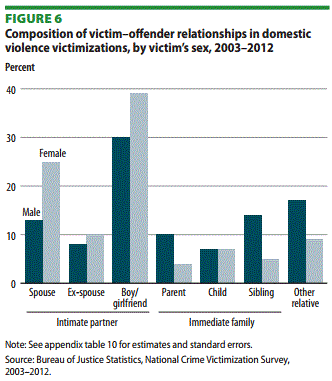The data show that for the period 2003-2012:
- Domestic violence accounted for 21 percent of all violent crime, while 32 percent was committed by well-known or casual acquaintances, and 38 percent by strangers.
- The rate of domestic violence declined 63 percent, from 13.5 victimizations per 1,000 persons in 1994 to 5.0 per 1,000 in 2012 (and violence committed by intimate partners declined at a faster rate than violent crime committed by immediate family members and other relatives). However, only about 56 percent of of violence by intimate partners and immediate family members, and 49 percent of violence by other relatives, was reported to police.
- Generally speaking, the majority of domestic violence was perpetrated against females (76 percent) compared to males (24 percent), but the proportions varied by family relationship.
- Females had higher rates of domestic violence victimization than males (6.2 per 1000 versus 1.4 per 1000). The rates of violence committed by immediate family members and other relatives were also higher for females than for males.
- Males and females alike were most likely to be victimized by a spouse or current/former boy/girlfriend. Males experienced higher percentages of victimization by an immediate family member (parent or sibling, for instance) and by other relatives.
- 18-24 year-olds had the highest rates of intimate partner violence (8.7 per 1,000), and 12-17 year-olds had the highest rates of violence by immediate family members (2.6 per 1,000). Persons ages 12-24 had the highest rates of violence by other relatives (1.2 per 1,000). Persons age 65 or older had the lowest rates of violence perpetrated by intimate partners (0.2 per 1,000), immediate family members (0.2 per 1,000), and other relatives (0.1 per 1,000).
- Non-Hispanic blacks (4.7 per 1,000) had the highest rates of intimate partner violence, compared to non-Hispanic whites (3.9 per 1,000), Hispanics (2.8 per 1,000), and non-Hispanic persons of other races (2.3 per 1,000). Persons of two or more races had the highest rate of violence committed by immediate family members (4.4 per 1,000). Whites (1.2 per 1,000) experienced more violence committed by immediate family members than blacks (0.7 per 1,000) and Hispanics (0.6 per 1,000). Blacks (1.2 per 1,000) experienced more violence perpetrated by other relatives than whites (0.6 per 1,000), Hispanics (0.6 per 1,000), and persons of other races (0.2 per 1,000).
Read more:
http://www.bjs.gov/content/pub/pdf/ndv0312.pdf
TeachingwithData.org resources:
Crime Victimization in the US: A Data-Driven Learning Guide (http://www.teachingwithdata.org/resource/3437)
Crime and Victims Statistics (http://www.teachingwithdata.org/resource/3261)
CrimeStat III (http://www.teachingwithdata.org/resource/3055)








I think that despite seeing how promising the statistics here show, we still have a long way to go. Let’s take into consideration the crimes being committed to younger kids, as well as those that are left unreported. Because the sad reality is domestic and sexual abuse is not just something that we can have the strength to report to the police, especially if the perpetrator is someone close to us, right?
ReplyDeleteRichard Della Fera @ RDF Attorney